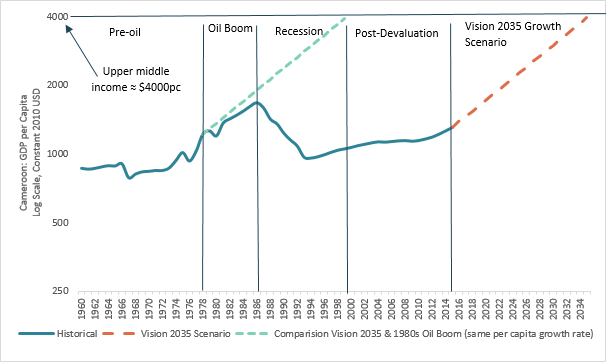After a decade of strong growth in the late 1970s and early 1980s, Cameroon was compared favorably with fast-growing East-Asian economies. This fame came to a sudden stop in the late 1980s when the country experienced one of the world’s deepest and most protracted recessions, triggered by large fall in the terms of trade and appreciation of the real exchange rate. Debts - previously at reasonable levels - mounted, banks failed and poverty increased. A 50% devaluation of the CFA Franc, a currency Cameroon shares with other former French colonies, in January 1994 pushed the foreign-currency denominated debt to increase to over 100 percent of GDP, triggering the Heavily Indebted Poor Countries (HIPC) debt relief process. Cameroon successfully exited HIPC in 2006. Since then, the authorities have set the goal to become a middle income country by 2035, anchoring their growth strategy on building infrastructure. After some initial success, with real growth steadily increasing from 1.9% in 2009 to 5.9% in 2014, the country is facing again some fiscal strains and risk of its debt distress has risen from low to moderate to high, in just 3 years.
Cameroon can still become an upper middle income by 2035 (figure 1), but it will have to anchor its growth strategy on something else than capital accumulation.
Figure 1: Reaching Upper-Middle-Income Status in 20 Years Is Daunting

Notes: 2016 WB Upper Middle Income level is $4036 pc (Atlas USD GNI) is expressed as $3973 GDP per capita (2010 USD) assuming that GDP and GNI grow at the same rate.
To become an upper-middle income country by 2035, as targeted in its Vision 2035 document, Cameroon will have to increase productivity and unleash the potential of its private sector. Specifically, Cameroon’s real GDP must grow by around 8 percent from now until 2035, which in turn will require the investment share of GDP to increase from around 20 percent of GDP to 30 percent of GDP and productivity growth to reach 2 percent over the same period, from its average rate of zero growth over the past decade.
These are daunting challenges. Sustaining growth at such rate for more than 20 years was achieved by only few countries: China, Korea, Vietnam, and Botswana. Furthermore, a 2% productivity growth was achieved by only 5 percent of countries over the past 25 years.
To make it happen the public sector would need to reinvent itself and change its nature: reduce distortion, promote innovation and increase allocative efficiency; and more competitive markets would be needed to promote productivity gains.
More competitive markets would promote productivity gains. Various factors hold back competition in Cameroon. High market concentration, state ownership of many of the largest firms, and government regulations limit competition. Widespread state participation in commercial activities that compete with the private sector deters investment. Cameroon’s limited competitive environment leads to considerable resource misallocation, where more productive firms are 10 times more productive than less productive firms on average.
The Cameroonian economy’s limited competitiveness at the domestic, regional, and global level points to the distortive role of a heavy-handed state.
Widespread state involvement in the productive sector limits domestic competition. Cameroon ranks 109 out of 144 countries in terms of local competitive intensity, 65 in terms of the extent of market dominance, and 78 in terms of the effectiveness of competition policy. Only a few large firms operate in most sectors and subsectors of the economy: 31 percent of manufacturing firms operate in oligopoly, duopoly, or monopoly markets, whereas in Kenya and Ghana, only 25 percent and 22 percent, respectively, operate in such markets. In subsectors that are key inputs for other activities—telecommunications, transport, and electricity—only one firm is in operation. Government participation in multiple companies increases market concentration limiting rivalry among firms. This is the case for electricity generation, palm oil, and bananas. Even when the government does not have shareholder control, it often has special rights that increases its influence on business decisions.
To shift growth strategy away from capital accumulation, a coordinated set of policies is needed to promote growth by increasing allocative efficiency and innovation, foster competitiveness by promoting local regional and global competition, and refocus the State on its core functions of regulation and economic promotion while withdrawing from production.
The Cameroon Economic Memorandum proposes a series of concrete actions and measures to promote growth, foster competitiveness and refocus the State on its core functions to ensure that Vision 2035 is within reach. Some of them are:
- Discontinue tax incentives and subsidies to loss-making companies, and discontinue public monopolies in contestable markets.
- Adopt an aggressive FDI attraction strategy targeting multinationals operating in sectors with high potential for job creation and export.
- Deregulate trucking industry to increase competition to reduce transport prices and enhance quality of services.
- Regulate common ownership of the operation of ports and railways infrastructure (fares and freights) to prevent restrictions on competition and monopoly pricing.
- Restructure SOE management governance to incentivize SOE performance, while mitigating the impact on competition.
- Withdraw from production in those sectors where the private sector is already successfully operating.



Join the Conversation